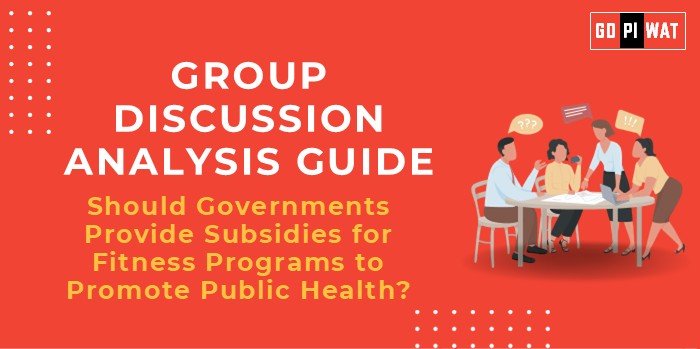📋 Group Discussion Analysis Guide: Should Governments Provide Subsidies for Fitness Programs to Promote Public Health?
🌐 Introduction to the Topic
Opening Context:
“As lifestyle diseases become a global challenge, governments worldwide face increasing pressure to promote public health. Subsidizing fitness programs could be a pivotal step in improving societal well-being and reducing healthcare costs.”
Background:
Public health experts attribute a rise in non-communicable diseases (NCDs) such as obesity, diabetes, and cardiovascular conditions to sedentary lifestyles. Subsidizing fitness programs could mitigate these trends, reduce healthcare expenditures, and boost productivity.
📊 Quick Facts and Key Statistics
- 🌍 NCD Death Toll: 41 million people die annually from NCDs, accounting for 74% of global deaths (WHO, 2023).
- 💰 Healthcare Costs: Physical inactivity costs the global economy $54 billion annually in direct healthcare and productivity losses (Lancet, 2022).
- 🏋️♀️ Fitness Industry Growth: Valued at $96 billion globally in 2023, reflecting increasing health awareness.
- 🇫🇮 Success Stories: Finland’s public fitness campaigns reduced obesity rates by 7% over two decades (2023 Study).
👥 Stakeholders and Their Roles
- 🏛️ Government: Funding, infrastructure, and policy design for fitness subsidies.
- 🩺 Healthcare Systems: Implementing programs to reduce treatment costs.
- 🏢 Fitness Industry: Partnering to offer affordable access and training.
- 🧍 Citizens: Participating to enhance personal health and reduce societal healthcare burdens.
🏆 Achievements and Challenges
✨ Achievements:
- 🇫🇮 Finland’s National Fitness Program: Reduced NCD rates, saving $1 billion annually.
- 🇯🇵 Japan’s Health Points Program: Rewarding healthy behaviors led to a 12% increase in activity levels.
- 🇮🇳 India’s Fit India Movement: Boosted awareness with 60% participation in urban schools.
⚠️ Challenges:
- ⚖️ Equity: Reaching marginalized and rural populations.
- 💸 Funding: Balancing subsidies with other public needs.
- 📚 Awareness: Limited understanding of fitness benefits, especially in low-income groups.
🌍 Global Comparisons:
- 🇦🇺 Australia: Effective “Active Kids” program providing financial incentives for physical activities.
- 🇨🇳 China: Nationwide campaigns successfully increased public gym usage by 35%.
💬 Structured Arguments for Discussion
- ✔️ Supporting Stance: “Subsidies for fitness programs will reduce healthcare costs, improve productivity, and promote healthier societies.”
- ❌ Opposing Stance: “Government funds should prioritize critical healthcare needs over fitness subsidies, which may not guarantee participation.”
- 🔄 Balanced Perspective: “While subsidies address public health challenges, they require careful planning to ensure equity and impact.”
🎯 Effective Discussion Approaches
🚀 Opening Approaches:
- 📊 Use Impactful Data: “Non-communicable diseases cause 74% of deaths worldwide, underscoring the urgent need for preventive measures like fitness subsidies.”
- 📚 Start with a Global Case: “Finland’s public fitness campaigns reduced obesity by 7%, proving the efficacy of such initiatives.”
💡 Counter-Argument Handling:
- ✔️ Acknowledge Funding Concerns: “While funding is a challenge, long-term healthcare savings justify the investment.”
- 📈 Highlight Success Stories: Use global examples like Japan’s Health Points Program to counter skepticism about impact.
🔍 Strategic Analysis: Strengths, Weaknesses, Opportunities, Threats
- 💪 Strengths: Reduced healthcare costs, improved public health, potential productivity gains.
- ⚖️ Weaknesses: Cost-intensive, uneven implementation, cultural resistance.
- 🌱 Opportunities: Partnerships with fitness providers, leveraging technology for monitoring.
- ⚠️ Threats: Misallocation of resources, lack of sustained interest.
🎓 Connecting with B-School Applications
🌐 Real-World Applications:
- 📈 Policies and projects on public health economics.
- 💻 Wellness tech initiatives and behavior change strategies.
🤔 Sample Interview Questions:
- ❓ “How can fitness programs reduce healthcare expenditures?”
- ❓ “What role does public-private collaboration play in fitness initiatives?”
💡 Insights for Students:
- 🔍 Explore the intersection of wellness and business in healthcare projects.
- 📊 Focus on sustainability initiatives tied to fitness and public health.


